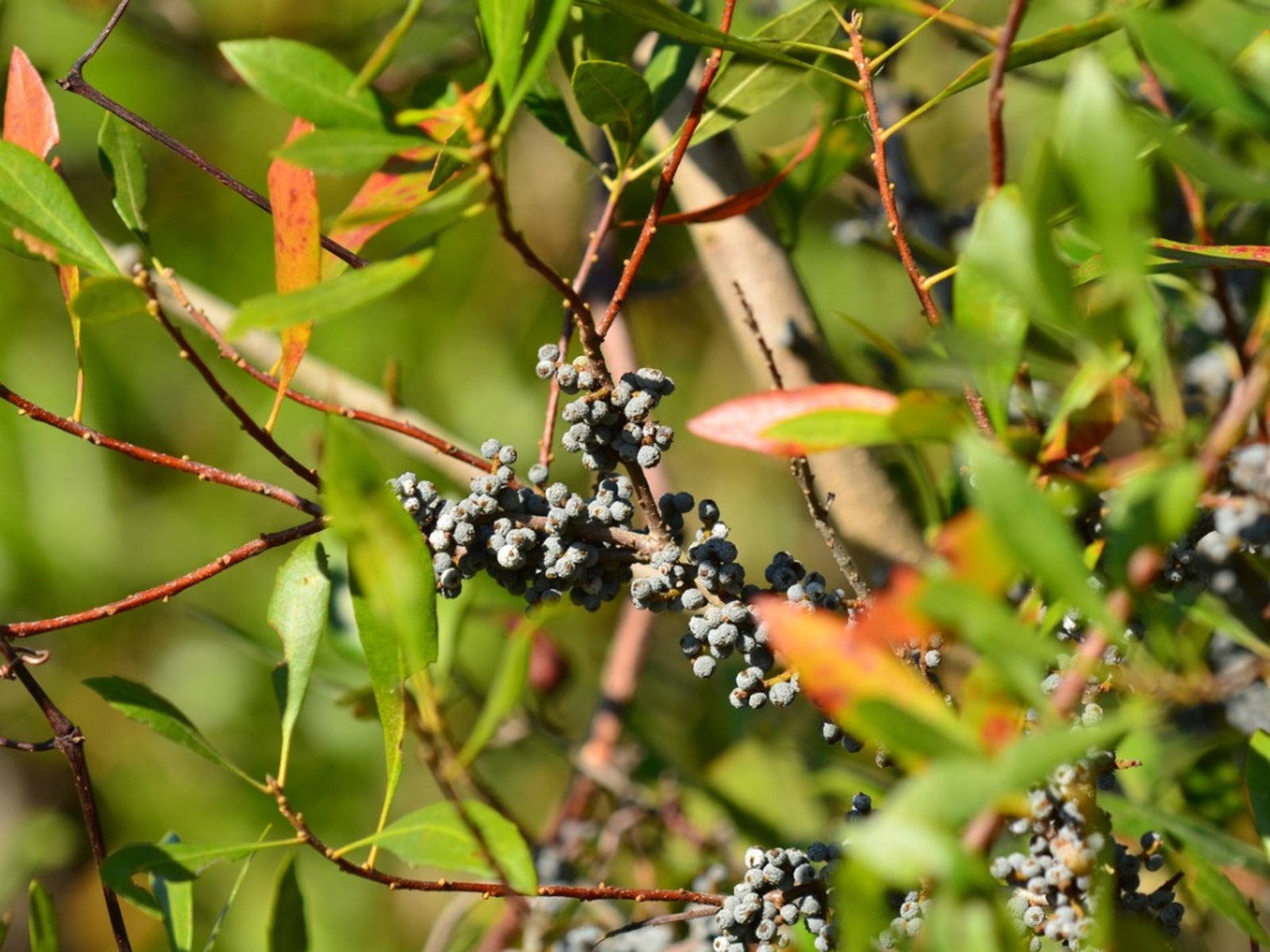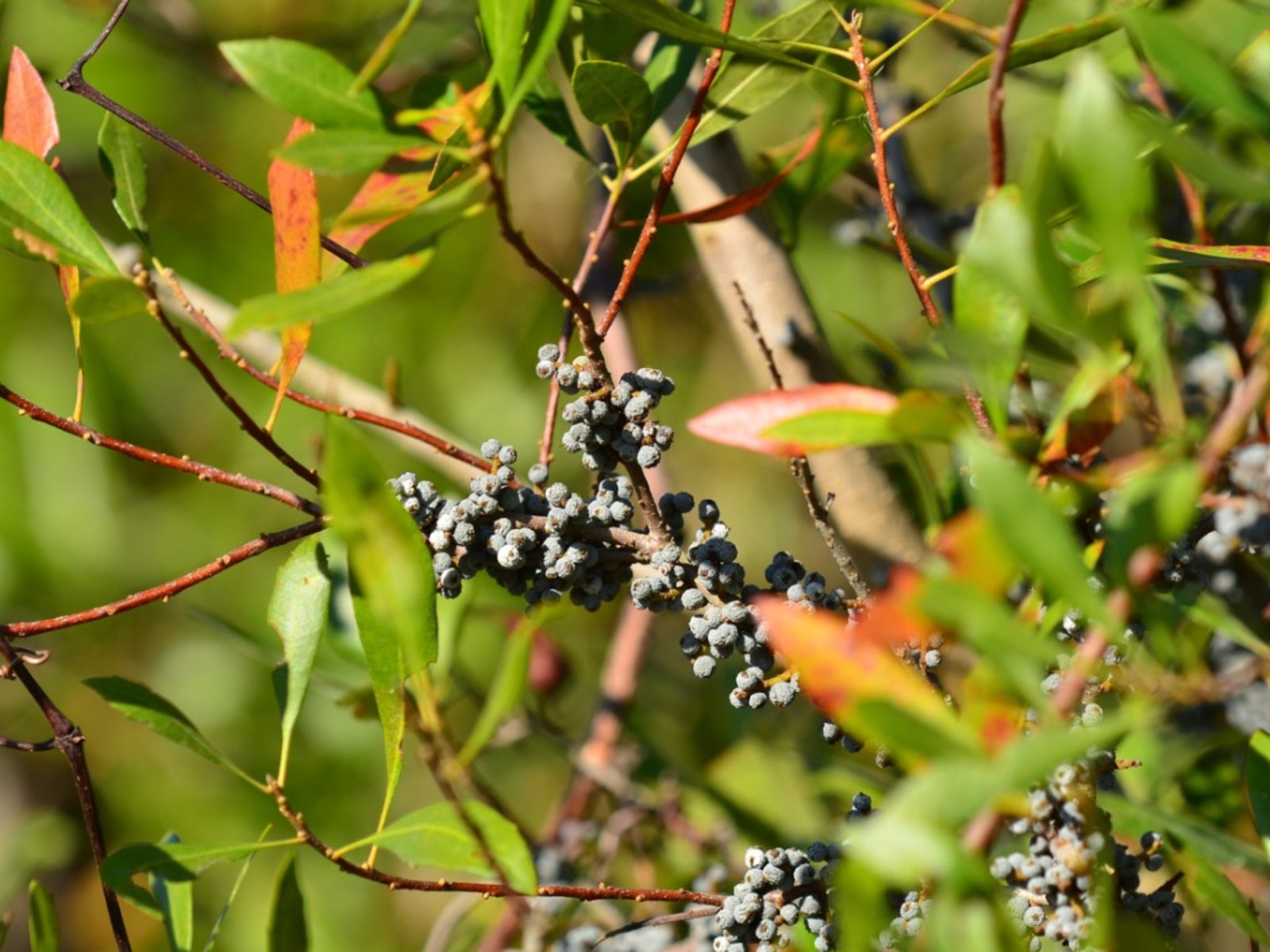Wax Myrtle Care: How To Plant Wax Myrtle In Your Garden


Teo Spengler
- Botanical name: Morella cerifera; formerly Myrica cerifera
- Height: to 20 feet but often smaller
- Spread: to 20 feet but often smaller
- Sun exposure: partial shade to full sun
- Soil requirements: good drainage and slightly acidic soils.
- Hardiness zones: 7-10
- When to plant: transplant in spring or fall
Wax myrtle (Myrica cerifera) is a small, broadleaf evergreen shrub that makes an excellent addition to almost any landscape. In the South they're popular grown as hedges, but these attractive trees can also be used as specimens. Read here about growing tips for wax myrtle trees and shrubs.
Growing Wax Myrtle Trees
There is so much to love about a wax myrtle tree. As specimen trees, they form many-stemmed canopies of aromatic olive green leaves on smooth, twisted trunks. Some trees are male, others females. The females bear inconspicuous flowers in spring, followed by clusters of gray-blue, waxy berries beloved by wildlife. (When selecting a wax myrtle, be aware that both female and male plants and are needed to produce fruit.)
These ornamental features, plus the plant’s easy-care ways have made wax myrtle - also known as Southern bayberry - an extremely popular landscape plant in warm-winter regions. It thrives in USDA hardiness zones 7 through 10.
Wax Myrtle Care Tips
Tough and durable, Southern wax myrtle trees do not need kid-glove treatment to thrive. They do well in almost all growing conditions, but tend to do best in slightly acidic, sandy soil with good drainage. Since they fix atmospheric nitrogen, they are not phased by poor or infertile soils. That, paired with their high tolerance for salt spray and salinity in the soil, makes them a popular choice for planting in marshes and swamps, on the oceanfront, and along roads.
For years the wax myrtle tree was prized for its fragrance and flammability. Its waxy berries would be harvested and used to make bayberry candles. This is the source of its other name, Southern bayberry.
Wax myrtle often exhibits growth of 3 to 5 feet (1-1.5 m) a year. As a shrub, it has a rounded, narrow form and is attractive when limbed up for use as a small tree. Use the wax myrtle tree in mixed shrub borders and as shade for the deck or patio. When growing wax myrtle, avoid planting annuals and perennials around the roots of this plant. Root disturbance or injury results in numerous suckers that must be pruned to keep the plant healthy.
The fruit of the wax myrtle tree is an important source of food for birds, including the tree swallow, catbird, brown thrasher, and Myrtle Warbler, whose love of the tree earns it its name. Grayish white clusters of fruit with a bluish, waxy coating remain on the plant throughout the winter in USDA zones 7 to 9. Flowers appear in spring, and are small with a greenish tint.
Gardening tips, videos, info and more delivered right to your inbox!
Sign up for the Gardening Know How newsletter today and receive a free copy of our e-book "How to Grow Delicious Tomatoes".
Wax myrtles are natural hosts for Red-Banded Hairstreak butterflies, a beautiful species of pollinator native to the southeastern United States.
How to Plant Wax Myrtle
Plant wax myrtle in full sun to part sun or part shade, in an area where roots will not be disturbed. This plant is salt-tolerant and takes sea spray well, making it an exceptional beachfront planting. The wax myrtle is adaptable to a range of soils, but prefers the soil to be moist. When growing wax myrtle, plant it where you can enjoy the bayberry fragrance emitting from the glossy foliage and berries.
Wax myrtle can be grown as a small tree or shrub, depending on your landscape needs. If you opt for a tree shape, prune up the canopy and restrict the trunks to one. That will expose the bark, a very attractive pale shade of gray. When several shrubs are grown together, they make very effective screens or hedging.
These trees are very sensitive to cold so, in cooler zones, choose a protected spot. Leaves may drop in a cold spell.
Problems and Challenges with Wax Myrtle
Don’t stay up nights worrying about insects attacking your bayberry plants. They generally do not suffer from any serious plant diseases or show vulnerability to insect pests. Planted in high pH soils, however, these shrubs can get iron chlorosis. Keep your eye out for the classic yellowing of the leaf tissue between the veins.
The leaves, stems and branches of wax myrtle smell good. This is because they contain aromatic compounds that also happen to be flammable. That makes these shrubs potential fire hazards in some areas. Space them away from the house.
Some consider wax myrtle invasive. That’s because the shrubs tend to sucker. They can form sizable colonies in excellent growing conditions. If you want to limit their spread, prune out suckers as they appear.
Cultivars of Wax Myrtle
Breeders have developed more than a few cultivars for this popular plant. By selecting an appropriate cultivar you can control the form and height of the plant. Some commonly grown cultivars include:
Wolf Bay
This is a tall (to 20 feet or 6 m), thick, upright cultivar with a cool name.
Don’s Dwarf
The opposite of Wolf Bay, this cultivar is compact, rarely growing about 5 feet (1.5 m) tall and wide and often staying closer to 3 feet (.9 m). This is a female cultivar and is resistant to leaf spot. Grows to 20 feet tall, and is more upright and thicker.
Tom’s Dwarf
Similar to Don’s Dwarf but a male cultivar. It generally gets no higher than 4 feet (1 m) but occasionally rises to 6 feet (1.8 m), with an equal spread. It is also resistant to leaf spot.
Hiwassee
Larger and more cold hardy than others, this species has been known to brush off temperatures down to -4 °F (24.8 F) without showing leaf burn.
Fairfax
This smaller cultivar tops out at 8 feet (2.4 m) high and wide. It has a compact mounding form with smaller, lighter green leaves. It will colonize an area quickly if left to its own devices.

Becca Badgett was a regular contributor to Gardening Know How for ten years. Co-author of the book How to Grow an EMERGENCY Garden, Becca specializes in succulent and cactus gardening.
- Teo SpenglerWriter
-
 Looking For Plants To Give You The Soft And Fuzzies? Try These 5 Fuzzy Leaf Plant Options
Looking For Plants To Give You The Soft And Fuzzies? Try These 5 Fuzzy Leaf Plant OptionsLovers of texture, drama, silver foliage and tactile plants will adore these special sensory garden additions. These fuzzy leaf plant options will leave you all aglow
By Susan Albert
-
 Get Ready For A Summer Of Hummers! Grow These Full Sun Hummingbird Plants and Flowers
Get Ready For A Summer Of Hummers! Grow These Full Sun Hummingbird Plants and FlowersIf you’re lucky enough to enjoy a sunny backyard, make sure you are maxing out on your pollinator opportunities and grow these full sun hummingbird plants and flowers
By Tonya Barnett
